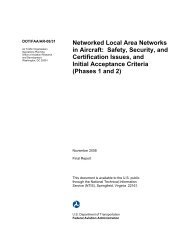Published Report (DOT/FAA/CT-94-36)
Published Report (DOT/FAA/CT-94-36)
Published Report (DOT/FAA/CT-94-36)
Create successful ePaper yourself
Turn your PDF publications into a flip-book with our unique Google optimized e-Paper software.
This is a very high rate, which would not be approached in actual<br />
operations. Since the actual blunder rate seems to be much<br />
smaller, the risk of the operation may be assumed to be much<br />
smaller than the target, acceptable risk.<br />
If it is assumed that 1/10 is the ratio of Worst Case Blunders to<br />
30° blunders the ratio would become<br />
130" Blunder<br />
10,2 10 triple approaches<br />
This rate may be the same order of magnitude as the actual, but<br />
unknown, blunder rate. However, since this rate represents an<br />
acceptable rate which will result in an accident rate no larger<br />
than the target rate, the risk of the operation is still deemed<br />
acceptable.<br />
7.0 SUMMARY AND CONCLUSIONS<br />
Historical accident data indicate that the current probability or<br />
risk of a fatal accident during an ILS approach in instrument<br />
meteorological conditions is about 4 x Since ten primary<br />
causes of a fatal accident during the approach may identified,<br />
including a midair collision with an aircraft on an adjacent<br />
approach, the target or acceptable risk rate may be determined to<br />
be 4 x or 1 fatal accident per 25 million instrument<br />
approaches.<br />
The window of risk may be determined analytically for two<br />
aircraft on adjacent approaches from knowledge of their relative<br />
positions, their speeds, and the blunder angle. Using this<br />
information, the number of at-risk blunders from simulated flight<br />
track data was determined to be 186.<br />
Analysis of the simulated flight track data also indicated that<br />
two TCV's occurred. Confidence intervals for the Bernoulli<br />
probability parameter were used to conservatively estimate the<br />
probability of a TCV given an at-risk blunder to be 0.049.<br />
Conversations with controllers were used to estimate the ratio of<br />
worst case 30' blunders to 30° blunders to be between 1/100 and<br />
1/10. Using the ratio, 1/100, the acceptable blunder rate was<br />
determined to be 1 30' blunder per 1021 triple approaches. Using<br />
the ratio, 1/10, the acceptable blunder rate was determined to 1<br />
30° blunder per 10,210 approaches. In either case, the operation<br />
would meet the target risk rate.<br />
aU.S. GOVERNMENT PRINTING OFFICE: 19<strong>94</strong>-504-078-00067<br />
L-14

















